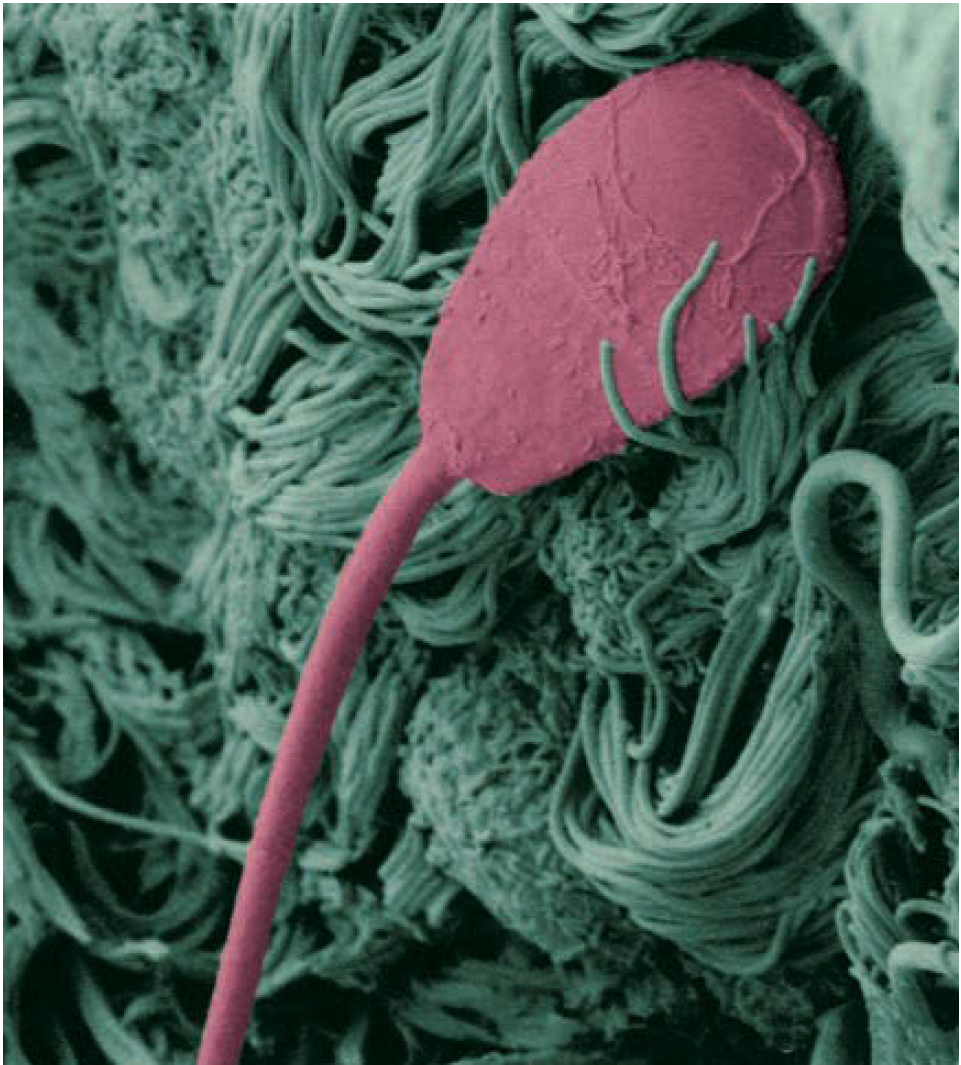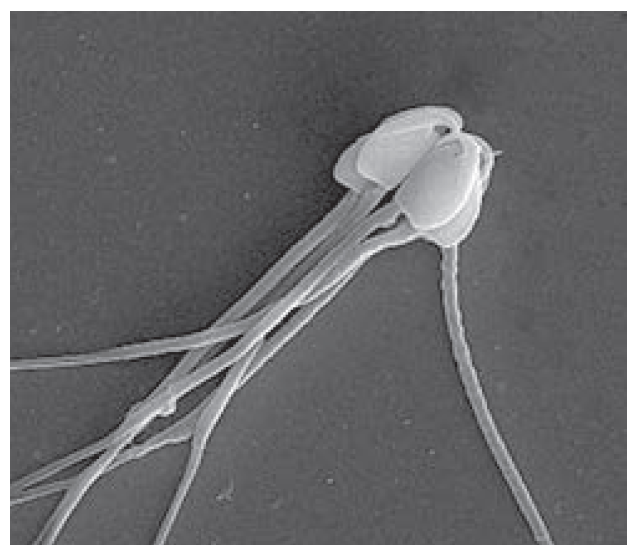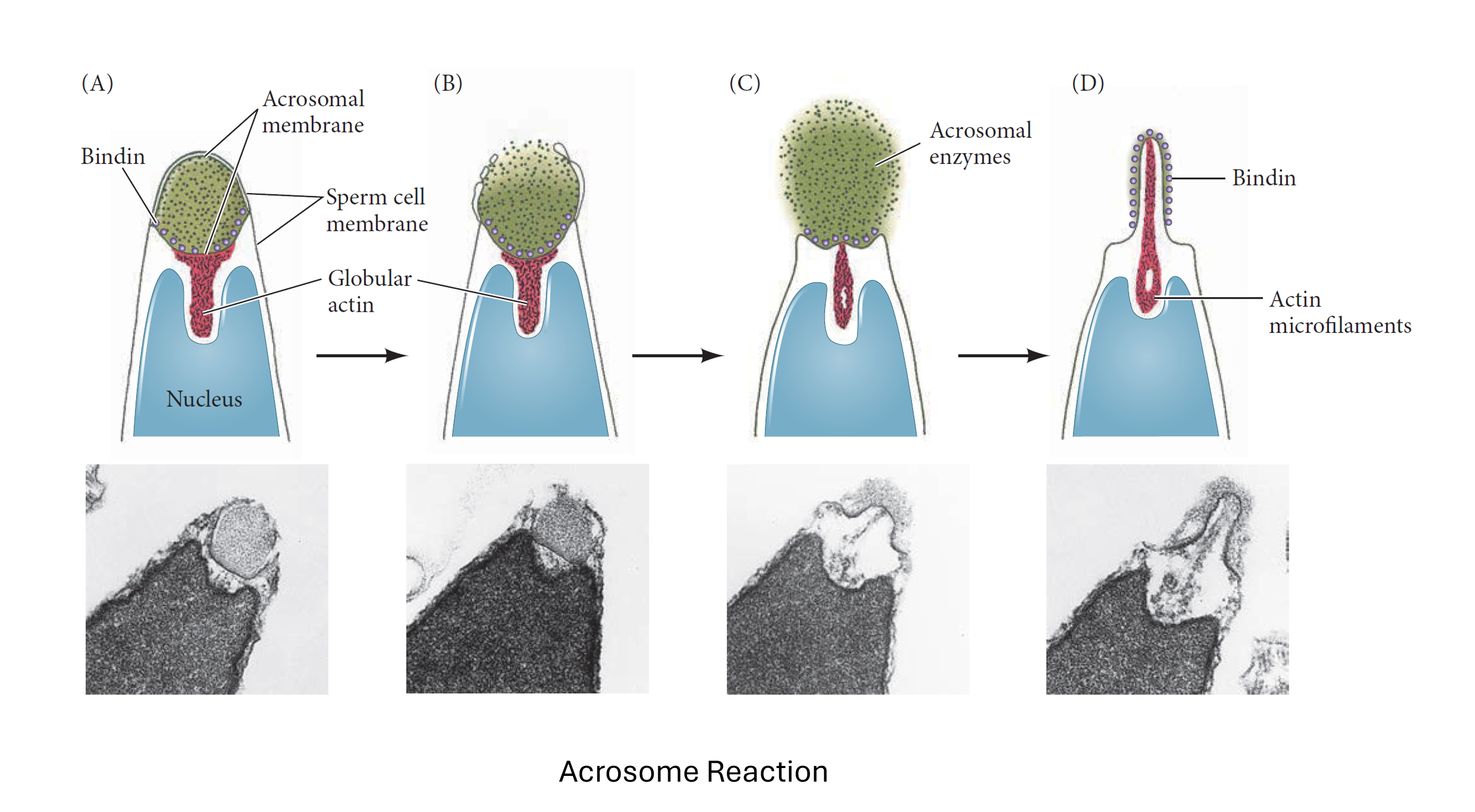-

Mammalian Fertilization: Sensing Mechanism Near the Oocyte
Hyperactivation is a crucial phase in sperm migration, occurring towards the end of capacitation. It is characterized by increased swimming velocity and force, asynchronous flagellar beating, and detachment from oviduct epithelial cells. This phase enables sperm to respond differently to fluid currents and aids in their detachment from the oviduct. Thermotaxis refers to the ability…
-
Gamete Fusion and Prevention of Polyspermy in Mammals
In mammals, the side of the sperm head contacts the egg, initiating the acrosome reaction, which releases enzymes and exposes the inner acrosomal membrane. Membrane fusion starts at the equatorial region, aided by actin polymerization extending microvilli from the egg to the sperm.
-

Mammalian Fertilization: Translocation
Mammalian fertilization is an intricate process occurring within the female reproductive tract, which actively regulates the transport and maturity of gametes[. The **oocyte-cumulus complex** plays a crucial role, with cumulus cells forming a protective matrix around the oocyte, aiding its transport to the ampulla of the oviduct. **Sperm translocation** involves several mechanisms, including sperm motility,…
-

Activation of the Mammalian Egg
In mammalian eggs, the rise in cytoplasmic calcium ions (Ca2+) plays a crucial role in egg activation. Sperm-induced Ca2+ waves trigger events such as meiosis resumption, cortical granule exocytosis, and maternal mRNA release. Surprisingly, sperm-derived PLCζ, delivered during gamete fusion, is essential for Ca2+ oscillations and successful egg activation. These oscillations, regulated by various proteins,…
-

Acrosome Reaction
The acrosome reaction is a crucial process in fertilization, enabling the sperm to penetrate the egg’s protective layers and achieve fertilization. This reaction involves a series of biochemical and structural changes in the sperm’s acrosome, a cap-like structure covering the anterior part of the sperm head.
-

Fertilization
In the intricate dance of fertilization, mammalian eggs undergo fascinating processes. From pronuclear migration and DNA uncoiling to the interplay of mitochondria and cytoplasmic contributions, each step contributes to the formation of new life. Sperm-egg interactions, centrosomes, and the orchestration of mitotic spindles—all converge in this remarkable journey.
-

Mammalian Fertilization: Capacitation
Capacitation is a vital process that enables mammalian sperm to fertilize an egg. Unlike amphibians or sea urchins, mammalian sperm are initially immature and require capacitation during their journey from the vagina.
-

Activation of Egg Metabolism in Sea Urchins
Introduction Fertilization is a crucial step in animal development that initiates the processes that lead to development. The events that occur during fertilization happen in the cytoplasm and involve the release of calcium ions. Calcium ions play a vital role in activating the egg’s metabolism and initiating development by releasing inhibitors from maternally stored messages,…
-

Cortical Granule Reaction (Sea Urchin)
Introduction Role of Calcium in Initiating the Cortical Granule Reaction Visualizing Calcium Release Conclusion
-

Fusion of the Egg and Sperm Cell Membranes and Polyspermy (Sea Urchin)
I. Introduction II. Fusion of Sperm and Egg Cell Membranes III. Monospermy IV. Polyspermy V. Fast Block to Polyspermy VI. Slow Block to Polyspermy VII. Conclusion
-

Recognition of the Egg’s Extracellular Coat (Sea Urchin)
Introduction Species-specific Recognition Events Binding of Sperm and Egg Biochemical Studies on Bindin Evolution of Gamete Recognition Proteins Conclusion
-

Acrosome Reaction (Sea Urchin)
Introduction Activation of the Acrosome Reaction In Strongylocentrotus purpuratus Extension of the Acrosomal Process Barrier to Interspecies Fertilization
-

Sperm Attraction (Sea urchin)
Introduction Species-Specific Chemotaxis Resact in Arbacia punctulata Conclusion
-
Structure of Egg
Delve into the intricate structure of mammalian eggs, from their cytoplasmic components to their nucleus, membrane, and interactions with sperm. Understand the crucial role of fertilization and egg development in the reproductive process.
-

Karl Ernst von Baer: A Pioneering Scientist in Embryology
Karl Ernst von Baer stands as a trailblazer in the realm of embryology, leaving an indelible mark on our comprehension of vertebrate development. His groundbreaking revelations encompassed the identification of pivotal structures like the notochord and the mammalian egg. Von Baer’s keen observations and meticulous comparisons led to the formulation of “von Baer’s laws,” which…
-
Embryonic Homology
Embark on a journey into the realm of embryonic homology, uncovering the intricate relationships between structures derived from common ancestors. Distinguish homology from analogy and explore how developmental changes drive evolutionary transformations. Dive into the world of artificial selection and gene mutations, unveiling their roles in shaping diverse species.
-
Commitment in Embryonic Development
Dive into the intricate process of commitment in embryonic development, where undifferentiated cells transform into specialized types. Explore the stages of specification and determination, and how cell fate and complex structures are shaped. Uncover the strategies various species employ in this fundamental journey.
-
Autonomous Specification
Delve into the realm of embryonic cell commitment through the lens of autonomous specification. This strategy, found in various organisms like snail Patella and tunicate embryos, involves the independent determination of cell fate within the egg cytoplasm. Discover how specific regions and factors influence gene expression, ultimately steering cells toward distinct destinies. Explore the groundbreaking…
-
Conditional Specification
Explore the fascinating concept of conditional specification in embryonic development, where cell destinies are shaped by interactions with neighboring cells. Unveil the significance of juxtacrine and paracrine factors, as well as mechanical stress, in determining cell fates. Discover how pivotal experiments by pioneers like Wilhelm Roux and Hans Dreisch challenged traditional notions of autonomy. Delve…
-
Syncytial Specification
Delve into the intricate strategy of syncytial specification, a unique approach to cell fate determination. Explore its fusion of autonomous and conditional aspects, witnessed in the fruit fly Drosophila melanogaster. Uncover the significance of the syncytial blastoderm—a shared cytoplasm containing multiple nuclei—and how it plays a pivotal role in the simultaneous establishment of cell identities…
-
Vulval Induction in C. elegans
Dive into the intriguing world of vulval induction in C. elegans. Explore the transformation from male to female as hermaphrodites mature. Uncover the role of vulval precursor cells (VPCs) and the complex interplay of paracrine and juxtacrine signaling in forming the vulva. Delve into the significance of the anchor cell, LIN-3 protein, and the RTK…
-
Hippo Signaling Pathway
The Hippo signaling pathway, initially discovered in Drosophila, plays a pivotal role in regulating organ size by orchestrating cellular processes such as growth, division, and apoptosis. Unlike traditional signaling pathways, Hippo lacks a specific ligand or receptor, instead relying on intricate interactions and key players to govern its intricate cascade. Notably, the loss of Hippo…
-
Stem Cells
Delve into the fundamental aspects of the stem cell concept through these study notes. Explore the intricacies of stem cell division, potency variations, and the role of progenitor cells. From totipotent and pluripotent stem cells to the significance of adult stem cells, grasp the essence of these versatile entities that drive cellular diversity and tissue…
-
Stem Cell Regulation
Dive into the intricate world of stem cell regulation with these comprehensive study notes. Explore the dynamic interplay between extracellular and intracellular factors that dictate stem cell behavior. From the pivotal role of the stem cell niche to the influence of cytoplasmic determinants, transcriptional networks, and epigenetic patterns, uncover the mechanisms that steer stem cells…
-
Pluripotent Stem Cells
Explore the realm of pluripotent stem cells through these insightful study notes. Unveil their significance in research and therapy, their origin in the mammalian inner cell mass, and the intricate regulatory mechanisms that maintain their pluripotency. Delve into the orchestration of gene expression, the roles of key transcription factors, and the interplay of cell-to-cell interactions…
-

Gastrulation: The Foundation of Life
Explore the pivotal process of gastrulation in animal development. Learn how cells rearrange to form germ layers, creating the foundation for body structures and axes. Understand the significance of this stage as we delve into movements, axes development, and its crucial role in shaping organisms.
-

The Cycle of Life in Frogs
Delve into the intricate life cycle of the leopard frog Rana pipiens, from the inception of gametogenesis and fertilization to the transformative journey of metamorphosis. Explore the stages of cleavage, gastrulation, and organogenesis that shape this remarkable amphibian’s development. Witness the astonishing metamorphosis from tadpole to land-dwelling adult frog. This essay provides a captivating insight…
-

The Cycle of Life
Embark on a journey through the intricate cycle of life, spanning the developmental odyssey of animals. Explore the stages from fertilization to birth, metamorphosis, and gametogenesis. Witness how cells rearrange, germ layers form, and organs emerge during organogenesis. Uncover the transformative power of metamorphosis and the pivotal role of gametogenesis in perpetuating life. This overview…
-

Structure of Mammalian Sperm
Delve into the intricate world of mammalian sperm structure, where specialized cells undergo complex development to fulfill their crucial role in fertilization. Explore the components that make up sperm – the streamlined nucleus, enzymatic acrosome, and propelling flagellum. Uncover the dynamic process of capacitation, fine-tuning sperm for successful egg binding and fertilization. Discover how dynein…
-

Hormonal regulation of oogenesis
The hormonal regulation of oogenesis is a complex process that involves the interaction of multiple hormones produced by the ovaries, pituitary gland, and hypothalamus. This regulation ensures the proper formation and development of eggs, as well as the preparation of the uterus for fertilization. This article explains the roles of various hormones and their interactions…
-

Hormonal regulation of Spermatogenesis
The study notes explains the complex process of hormonal regulation of spermatogenesis. It describes how hormones produced by the testes, pituitary gland, and hypothalamus interact with each other and how negative feedback mechanisms play a crucial role in regulating the process. The article also emphasizes the importance of testosterone, FSH, and LH in spermatogenesis and…
-

Chick embryo development
Chick embryo development is a fascinating and complex process that involves a series of morphological changes from fertilization to hatching. Chick embryos are an excellent model organism for studying development due to their accessibility and similarity to human development. The development of a chick embryo involves six major steps: fertilization, cleavage, gastrulation, neurulation, organogenesis, and…
-

Fertilization in Sea Urchin
Fertilization in sea urchins is a complex process that involves a series of steps, beginning with the release of sperm and eggs and culminating in the formation of a zygote. The release of gametes is often triggered by environmental cues, and upon contact, the sperm undergoes a series of changes, including the release of enzymes…
-

Spermatogenesis
Spermatogenesis is the process of sperm cell formation and development, which occurs in the testes of males and is regulated by a delicate balance of hormones. It is a complex process that involves four main phases: the mitotic phase, meiotic phase, morphological maturation phase, and maturation phase. Each phase is characterized by specific events that…
-

Oogenesis
The text above discusses the process of oogenesis, which is the formation and development of egg cells in females. It is a complex process that occurs in the ovaries and is regulated by hormones, including estrogen and follicle-stimulating hormone. The process of oogenesis is divided into four main phases, including the mitotic phase, meiotic phase,…
-

Molecular Events of Amphibian Fertilization
Fertilization in amphibians is a fascinating process that involves a unique set of molecular events governing the successful fusion of male and female gametes. Unlike mammals, amphibians employ external fertilization, where the male releases sperm into the surrounding water, and the female lays her eggs. This process requires intricate cellular interactions, starting with chemotaxis and…
Categories
- Anatomy (9)
- Animal Form and Functions (38)
- Animal Physiology (65)
- Biochemistry (33)
- Biophysics (25)
- Biotechnology (52)
- Botany (42)
- Plant morphology (6)
- Plant Physiology (26)
- Cell Biology (107)
- Cell Cycle (14)
- Cell Signaling (21)
- Chemistry (9)
- Developmental Biology (36)
- Fertilization (13)
- Ecology (5)
- Embryology (17)
- Endocrinology (10)
- Environmental biology (3)
- Genetics (59)
- DNA (27)
- Inheritance (13)
- Histology (3)
- Hormone (3)
- Immunology (29)
- life science (76)
- Material science (8)
- Microbiology (18)
- Virus (8)
- Microscopy (18)
- Molecular Biology (113)
- parasitology (6)
- Physics (3)
- Physiology (11)
- Plant biology (26)
- Uncategorized (7)
- Zoology (112)
- Classification (6)
- Invertebrate (7)




